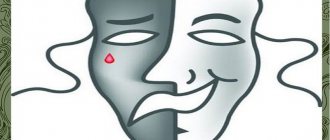What is ambivalence
Ambivalence in psychology is a dual attitude towards an object or person, feelings or experiences that contradict each other. The object evokes two completely opposite emotions.
The term “ambivalence” was first discovered by the Swiss psychiatrist Eugen Bleier at the beginning of the 20th century. In his opinion, this condition is a sign of schizophrenia.
Unlike Bleuer, Sigmund Freud believed that ambivalence is the peaceful coexistence of opposing impulses in the human soul. These impulses arise in two spheres (life and death) and are considered the foundation of personality. The scientist pointed to the fact that a person is born with dual emotions. At the same time, the positive ones are at the conscious level, and the negative ones are hidden in the depths of the subconscious. In favorable conditions, they “pop up”, provoking a person to unpredictable and sometimes inappropriate actions.
The world famous Carl Jung expanded the concept. According to him, the conscious and unconscious coexist harmoniously in the mechanism of action of the human psyche. What then is ambivalence in simple terms? This is the existence in the consciousness and subconscious of two opposing or conflicting feelings, desires, emotions or intentions in relation to the same person, phenomenon, object.
Interesting! F. Scott Fitzgerald said that ambivalence enhances the mental abilities of every person.
There are three types of ambivalence:
- Emotional ambivalence. Most often appears in romantic relationships. An individual experiences two different feelings towards the object of adoration.
- Strong-willed. Otherwise called ambition. What does it mean? A person has two opposing goals and, accordingly, expects two results. It is difficult for him to choose between them, which is why he postpones making a decision.
- Intellectual ambivalence. The principle is the same as in the two previous cases. Only here it comes down to conflicting ideas.
There is also a fourth type - social ambivalence. An example is a person who simultaneously lives according to generally accepted laws and zealously attends church. This also includes the common term – Orthodox atheist. There is duality.
Main types of duality
The aforementioned Bleuler identified three types of ambivalence
:
- Emotional
– simultaneously a negative and positive attitude towards objects and events (for example, the attitude of children towards their parents); - Volitional
– hesitation between opposing decisions, which often ends in a refusal to make a decision at all; - Intellectual
– alternation of opposing judgments, mutually exclusive ideas in a person’s reasoning.
Social ambivalence is also sometimes highlighted. It is caused by the fact that a person’s social status in different situations (at work, in the family) can be different. Also, social ambivalence can mean that a person fluctuates between heterogeneous, contradictory cultural values and social attitudes.
For example, a person can live according to the laws of the secular world and at the same time attend church and participate in rituals. Often people themselves point out their social ambivalence, calling themselves, for example, “Orthodox atheists.”
Another psychotherapist, Sigmund Freud, understood the concept of “ambivalence” somewhat differently. In it, he saw the simultaneous existence in a person of two opposing initial drives, the main ones being two drives - the drive to life and the drive to death.
Ambivalence in psychology and psychiatry
Until the beginning of the 20th century, the meaning of the word ambivalence was considered only in medical practice. But after, as mentioned above, they began to study it in psychology. Psychologists believe that this condition is the norm. Therefore, there is no need to try to get rid of it. The main thing is to monitor its manifestations. However, it is worth remembering that in some cases the fragile human psyche “breaks.” As a result, neuroses and other serious problems develop. Such cases include:
- use of psychotropic drugs, alcoholic beverages, narcotic substances;
- severe stress or psychological shock;
- traumatic situations that left an indelible mark on the mind.
This also includes the use of techniques for changing or expanding consciousness. We are talking about neurolinguistic programming. In psychiatry, ambivalence is considered a symptom of many serious diseases. It is not considered as an independent pathology. Ambivalence is usually associated with mental disorders. As mentioned above, one of them is schizophrenia. There are others:
- depression in the chronic stage;
- psychosis;
- panic fear;
- various fears;
- neuroses;
- obsessive-compulsive disorder.
Ambivalence in such pathologies is the simultaneous existence of several feelings, emotions, sensations. They don't mix with each other.
What are the causes of ambivalence?
Another important question is why ambivalence arises in people. The reasons for a dual perception of reality may be different. There are also different types of ambivalence. Mentally healthy people may experience social and intellectual ambiguity. Emotional ambivalence, leading to serious consequences, is inherent in people suffering from mental problems of varying severity.
However, people with a healthy psyche can also feel a temporary split of feelings caused by a specific situation. The difference is that a healthy person finds a way out of it and chooses the right strategy, while a mentally unstable person continues to suffer, worsening his condition.
An ambivalent state can result from uncertainty, neurasthenia, and hysterical states. For example, in relation to parents, ambivalence arises due to violations of the boundaries of personal space.
Contradictory upbringing can become a source of ambivalence towards cultural and moral values. Conformism also generates obedience to state power and the desire to possess forbidden things, a craving for forbidden ideas. This phenomenon could be observed during the Soviet era.
Ambivalent thinking can be a companion to certain pathologies:
- Schizophrenia and schizoid states.
- Depression.
- OCD or obsessive-compulsive disorder.
- For bipolar mental disorder.
- For neuroses.
The human psyche is a complex mechanism that only a specialist can understand. It is the psychologist, psychiatrist, psychotherapist who must make a diagnosis and develop a treatment strategy, if necessary.
Why is ambivalence dangerous?
Until the beginning of the last century, the term ambivalent person was used only in medicine. After specialists in the field of the human psyche drew attention to this phenomenon, ambivalence appeared in psychiatry. From their point of view, most manifestations do not go beyond the norm. There is no point in waging an internal war with her. The main task is to monitor the manifestations and intensity.
However, ambivalent disorder may appear due to precipitating factors. These include:
- Various types of addictions, addiction to alcohol, drugs.
- Psychological trauma, severe stress.
- Post-traumatic syndrome.
- Occult practices to expand and change consciousness.
- Neurolinguistic programming.
In psychiatry, ambivalent behavior is not considered as a separate phenomenon. Ambivalence is a symptom of other diseases. The consequences of ambivalence in such cases can significantly affect the life of both the person himself and those around him, and can also be tragic.
How to get rid of ambivalence?
The question of how to treat ambivalence should arise only in the case of serious mental pathologies and other types of problems. All people tend to agonize before making a choice, this is natural. You shouldn’t make a tragedy out of the fact that you are tormented by conflicting thoughts over a trifle. Many people also tend to periodically have tense relationships with their parents and other relatives. Conflicting feelings after quarrels are also normal, as long as they do not become a motive for harming yourself or someone else.
If ambivalent behavior gets out of control, this is a reason to think about behavior correction. Diagnosis is carried out by a specialist using various tests, and he also prescribes treatment. The list of possible drugs for treatment includes: vitamins, antidepressants, sleeping pills, sedatives, normomics, antipsychotics, tranquilizers, nootropics.
The name of the pharmaceutical drug, dosage and duration of use can only be determined by a psychiatrist. A psychologist and psychotherapist use non-drug methods and dietary supplements in cases where ambivalence is not accompanied by serious mental disorders.
Causes of ambivalence in humans
An ambivalent state is a symptom of mental disorders. The reasons for their development are considered to be frequent stressful situations, conflicts, and strong experiences. As soon as the situation stabilizes, the duality disappears on its own. Sometimes ambivalence is a consequence of difficult relationships:
- Children develop ambivalence when they lack parental care or warmth. Another option is overprotection, when mom and dad allow themselves to invade the child’s personal space.
- Ambivalence between a man and a woman appears if one of them is not confident in his partner and constantly creates conflict situations. Another reason is instability in relationships.
Such situations provoke stress, depression, hysterics, and neurasthenic states. A psychotherapist, psychologist or psychiatrist can find out the exact cause of ambivalence. The choice in this case depends on the degree of its severity.
Clinical picture
Since the term in question has many definitions, when drawing up a clinical picture we will rely on the criteria used in the original (psychiatric) context. These criteria are divided into three groups: emotions, thoughts and will. In the case when the ambivalent state is considered as a pathology, the patient has all three of the above components, which are generated by each other.
Emotional ambivalence
Duality affecting the emotionally sensitive sphere has the highest prevalence. This symptom, characteristic of many neuroses and other mental disorders, often occurs in completely healthy people. A clear sign of duality in the emotionally sensitive sphere is the presence of several opposing emotions. An ambivalent attitude is the presence of feelings such as hatred and love, curiosity and fear, contempt and sympathy. In most cases, a healthy person is in a similar state of nostalgia, where sadness about the past gives rise to joy from pleasant memories.
The danger of this condition is explained by the fact that sooner or later, one of the conditions takes on a dominant role. In a situation where fear accompanies curiosity, tipping the scales in favor of the latter can lead to traumatic consequences and a threat to life. The dominance of hatred over love causes the launch of defense mechanisms, in which a person, under the influence of his own emotions, can cause harm to both others and himself.
With ambivalence, a person simultaneously experiences positive and negative feelings towards someone or something.
Polar thoughts and ideas
Polar thoughts and ideas are an integral part of neurotic disorders. Obsessive thoughts and ideas that replace each other in the human mind are a peculiar characteristic feature of mental illness
It should be noted that polar thoughts in consciousness appear solely due to the duality of emotional perception. The very range of human ideas can be unlimited in size
Duality of thinking in psychiatry is considered as a “crack” in consciousness, which is the main symptom of schizophrenia.
Volitional sphere
Volitional duality is characterized as the inability to carry out a specific action due to the presence of several stimuli. In order to better understand this condition, let's consider a situation in which a person experiences extreme thirst. In such conditions, an ordinary person will take a glass, pour water into it and quench his thirst. With volitional ambivalence, patients refuse water or freeze in one position with a glass in their hand, while not paying attention to the strong desire to drink. Most often, most people encounter this phenomenon when they simultaneously feel the desire to stay awake and go to sleep.
Experts who study volitional ambivalence say that refusal to make independent decisions is most often generated by internal conflicts. The cause of such conflicts can be irresponsible behavior or, conversely, increased responsibility, accompanied by a fear of making a mistake. The cause of internal conflict may be reduced self-esteem and increased self-criticism, fear of public attention and a tendency towards perfectionism, increased anxiety, indecisiveness and various phobias. An attempt to avoid a difficult choice is accompanied by the appearance of two polar feelings - shame for one’s own indecision and a feeling of relief. It is by the presence of these feelings that experts confirm the theory that each type of duality is closely interrelated with each other.
Ambivalent emotions, like ambivalence itself, can be both a difference in human consciousness and a symptom of a disease
That is why, during a diagnostic examination, increased attention is paid to the background manifestations of this condition.
Ambivalent behavior can be a sign of emotional instability, and sometimes the first sign of the development of mental illness
Examples of ambivalence
The ambivalent state has many facets and features. Some examples may surprise you:
- Love for parents and a strong desire to move away from them and live separately. In especially severe cases, they are even wished for death.
- Love for the child is mixed with the desire to get rid of him at least for a couple of days, sending him to his grandparents for upbringing.
- The desire to live in the same house with parents, but at the same time not to hear their moralizing and advice.
- Nostalgic memories of the past, in which there were losses of something important.
- Fear and curiosity. Strange sounds are heard in a dark empty room. The person is afraid, but still goes to see what is happening there.
- Sadomasochism. It's not just about sexual relationships. Remember the cases when a woman suffers with her alcoholic or drug addict husband, but does not dare to leave him.
Another example of ambivalence would be having to choose between two candidates. Everyone has good and bad qualities. But it is impossible to choose just one. To get the ideal option, I want to combine them into a single whole.
Symptoms and signs
The following signs and symptoms of ambivalence can help you navigate a problematic situation:
- Conflicting opinions.
- Actions that do not comply with the stated principles.
- Actions that do not correspond to intentions.
- Trouble concentrating on anything.
- Lethargy.
- Conflict.
- Depression, apathy, neuroses.
A person cannot understand his thoughts and feelings. Complex decisions are difficult to make, and he needs outside help.
External manifestations of internal conflict:
- Ignoring rudeness, although it causes pain, everyday sadomasochism.
- Fear of the dark and a burning desire to see the source of sounds from there.
- The desire of adult children to live with their parents, but the desire to avoid their moralizing.
- Strong maternal love, which is replaced by the desire to send the child to stay with relatives or to a children's camp for a while.
How ambivalent feelings manifest themselves
What does the concept of ambivalence of feelings mean? By definition, ambivalence is the duality of emotions, desires and ideas. This is a completely opposite attitude towards the same object. A person cannot make a choice in favor of one of the solutions. His behavior and emotional state are constantly changing. In the morning he could be calm and friendly. And in the evening he suddenly became hysterical, aggressive, provoking quarrels. Or another example, a “sick person” is usually a cautious, cowardly person. In an ambivalent state, he becomes reckless. Then he turns back into himself.
Such changes bring nothing but disappointment, panic, and discomfort. They lead to the development of stress, neuroses and depression. A striking example of the manifestation of ambivalence of feelings in psychology is the work of F. Dostoevsky “Crime and Punishment”. The main character really wants to commit a crime. But remember how afraid he is of decisive action. Duality in action. But in this case it is a symptom of a mental disorder.
Nowadays, ambivalence (especially social) manifests itself among some peoples. Take Turkey, for example. Local residents often cannot decide which culture they like: European or Asian. They don't want to break their religious laws. But at the same time, they are afraid of appearing too pious in front of foreign tourists. Sometimes women make excuses for wearing a headdress. They say it is comfortable and beautiful. Although in fact this appearance is observed in accordance with Islamic precepts.
Ambivalence is also common in Russia. And not only among ordinary people, but also among those in power. For example, Alexander the First at some point wanted to abolish the monarchy and introduce free elections. But he soon changed his views, making himself a cruel monarch.
Many people often do not have their own opinion, blindly following propaganda. On the one hand, they strive for what others impose on them. On the other hand, sometimes they consider it stupidity and try to live in accordance with their opinion. This is how ambivalence of behavior manifests itself.
Ambivalence is an example. Ambivalence of feelings
In relationships between people, ambivalence of feelings is quite common. This concept is defined by psychology as a contradictory attitude of the subject to an object, object, person, etc. He simultaneously accepts and rejects, refuses the object of his feelings.
This term was first introduced by the Swiss psychiatrist Bleuler, who characterized schizophrenia. However, the average person also experiences similar experiences. Experts associate ambivalence with the versatility of the internal needs that one person has, and the diversity of the surrounding world, which can attract and repel at the same time.
Z. Freud considered this phenomenon to be the norm, as long as it manifests itself in short periods and is not bright. Otherwise, neuroses begin to develop. A person can feel love and hate, pleasure and displeasure, sympathy and antipathy at the same time. Often one feeling is disguised as another.
In psychology there are two definitions for this phenomenon:
- Ambivalence is the duality of a person’s feelings towards another individual, phenomenon or event. It often manifests itself in relation to objects that have an ambiguous relationship for a person. This is different from exclusively positive or negative emotions, which some psychoanalysts interpret as idealization or devaluation of the object. Thus, ambivalence of feelings is considered normal.
- Ambivalence in psychiatry is considered as a splitting of personality, which alternately experiences one and then opposite feelings.
Ambivalent feelings are emotions that a person experiences simultaneously. Mixed feelings are experiences that manifest themselves alternately.
Vivid examples of the manifestation of ambivalence are child-parent relationships and unions of people in love. On the one hand, a child may wish his parents to die, on the other hand, he may need them and sincerely love them. On the one hand, partners can love each other, but at the same time understand that they hate each other.
How can this be explained? The duality of feelings can be explained by the fact that in a person instinctive needs and the foundations of society are intertwined, which are embedded in the person’s head. Take, for example, a love union where spouses love and hate each other.
- On the one hand, they are forced to play the role of lovers because they feel the need for it. Perhaps they no longer love each other, but since they remain together, they are forced to direct it towards those who are nearby. This can be explained by the principles that are accepted in society, where spouses should love each other, even if this is not the case.
- On the other hand, spouses hate because they identify situations where their loved ones hurt them. Consciously, they understand that they are not loved, otherwise they would not cause pain. This causes hatred, which they try to hide, since it can destroy the union that is accepted and encouraged by the people around them.
Ambivalence in relationships
Ambivalence in relationships is common. Just remember the common phrase that from hatred to love there is one step. “I love and I hate” - you’ve probably heard (more than once) these words. For clarity, here are some examples:
- The wife loves her husband. But he experiences a lot of negative emotions due to strong jealousy.
- A woman adores her son or daughter. But out of fatigue, she sometimes wants to pour out all her irritation, anger, and resentment on them.
- The child loves his parents and tries to spend as much time with them as possible. But at the same moment he dreams that they would not interfere in his life.
- The girl loves her chosen one. But she is irritated by some of his qualities. And close friends provoke us to reconsider relationships.
If ambivalence of emotions in a relationship appears for a short period of time, there is no need to worry. Short-term emotions will not cause harm. Otherwise, serious mental disorders can be judged.
Ambivalence - normal or disease
The word comes from the merger of two Latin expressions: both ambo and strength valentia. Literally, this means opposite directions of feelings of equal strength, for example, the uncontrollable ability to love and hate someone at the same time.
Definition in psychology
Since the time when, in addition to medical psychiatry, psychologists paid attention to ambivalence, it was proposed to consider it in two planes, namely:
- in psychoanalysis;
- in clinical psychology.
Sigmund Freud, a psychologist and psychoanalyst from Austria, considered ambivalence to be a complex range of feelings inherent in every person and embedded in the depths of the subconscious. He considered this to be the norm, indicating that from birth an individual has attractions to both life and death.
Attention! Ambivalence in psychology is a sign of the normal state of a person who has not clearly defined his attitude towards someone or something. This is a borderline condition that just needs to be closely monitored rather than attempted to be treated.
“From love to hate there is one step!” - a well-known phrase says that in one person in relation to another, two opposite feelings can coexist in the depths of consciousness. One of them currently has an advantage, but for some reason the situation may change
This is a borderline condition that just needs to be closely monitored rather than attempted to be treated. “From love to hate there is one step!” - a well-known phrase says that in one person in relation to another, two opposite feelings can coexist in the depths of consciousness. One of them has an advantage at the moment, but for some reason the situation may change.
By the way. Masters of psychoanalysis argue that deviation is most likely an unambiguous position of sensations. Having divided the world only into “black” or “white”, a person is deprived of the taste of life - halftones. Helping him regain his natural ambivalence is the task of the psychoanalyst.
This case is exactly what clinical psychology does. The individual experiences a splitting of the ego. The psychological defense mechanisms of his consciousness periodically change his attitude towards the object of feelings.
Example. The son idolizes his parents in the morning (they are the best), and by the evening he is ready to kill them (it would be better if they did not exist at all). This is a borderline mental state in which the son sincerely believes that those parents who were with him in the morning are good, and those who are with him in the evening are bad.
Important! Internal defense works with distortion so that the son cannot collect his feelings into a single whole and apply them to one object - his parents. For an individual, the same object is spread over time, and different relationships are applied to it
Ambivalence as the norm
What is it in psychiatry
Psychiatry considers ambivalence as a manifestation of a mental disorder. The Swiss Bleuler considered it a direct sign of schizophrenia or any form of schizoidism (withdrawal from reality by withdrawing into oneself). His colleagues in psychiatry note that ambivalence is not necessarily a separate pathology, but may be associated with the following disorders:
- chronic depression;
- phobias and panic fears;
- OCD – obsessive-compulsive disorder;
- BAD – bipolar affective disorder;
- neurosis.
People prone to reflection - self-analysis also have signs of ambivalence in their arsenal.
Schizophrenia
Diagnosis and treatment of ambivalence
There is no need to try to self-diagnose ambivalence. This should be done by a specialist: a psychologist, psychotherapist or psychiatrist.
Diagnostics
Diagnosis of ambivalence involves conducting a number of tests:
- Kaplan test for bipolar disorder;
- Priester test, which detects the presence of conflicts;
- conflictology test by Richard Petty.
But usually the presence of ambivalence is determined by the answers to the following questions:
- Do I open my soul to others?
- Are you ready to discuss problems with outsiders?
- Do I feel discomfort when having frank conversations with my interlocutor?
- Am I afraid that they will stop communicating with me?
- Do I feel anxious if others are not interested in me?
- Does dependence on others bring negative emotions?
You need to answer with a rating from 1 to 5. 1 – completely disagree, 5 – completely agree.
Treatment
Therapy must be comprehensive. First you need to identify the cause of ambivalence. It was said above that it is not a separate disease. This is usually a symptom of mental disorders. It remains to identify which ones. To stabilize the individual, the doctor prescribes several groups of medications:
- mood stabilizers - help in the fight against sudden mood changes;
- antidepressants – treat disorders in the brain that provoke the development of depressive conditions;
- tranquilizers - help get rid of anxiety, panic attacks, sleep problems, calm, relax;
- neuroleptics - improve concentration, which decreases in an ambivalent state;
- nootropics – normalize blood circulation in the brain, improve its activity in mental disorders;
- sleeping pills – improve sleep;
- sedatives – eliminate nervous tension, help cope with panic attacks and neuroses;
- B vitamins – normalize the functioning of the nervous system and effectively fight depression.
The dosage of drugs and the duration of treatment are determined by the doctor. In the case of ambivalence, self-medication is also dangerous. At the same time as taking medication, it would be good to make an appointment with a psychologist. It will help you find your weaknesses, understand your feelings, and find the reason for the development of ambivalence. These could be personal conversations, group classes, special trainings on personal growth.
If the methods described above do not help, it means that the ambivalent state has developed into a pathological one. You'll need a psychiatrist here. Otherwise, there will be serious problems in communication, an unexpected negative reaction to people and what is happening around.
Concept and essence
Ambivalence is a contradictory attitude towards different objects, phenomena, and people. A person has conflicting experiences. The term appeared at the beginning of the 20th century thanks to the work of Eugen Bleier. The researcher argued that this phenomenon is more pronounced in people suffering from schizophrenia.
At the same time, the term was studied and developed by Sigmund Freud. His point of view differed from Bleier's. He argued that ambivalence is the peaceful existence of a person in whom opposing impulses collide in the soul.
He called these beliefs the foundations of personality. Sigmund Freud argued that they are inherent in every person from birth. Initially, positive emotions predominate. Negative ones will form throughout life. If conditions are unfavorable, negative emotions begin to appear more often and can provoke a person to commit inappropriate actions.
The next scientist who made a great contribution to the study of this phenomenon was Carl Jung. He argued that conscious and unconscious manifestations coexist in the general mechanism of mental action.
Symptoms of ambivalence
Most often, the duality of perception and behavior manifests itself in the form of such features as:
- opposing thoughts that contradict each other, but are perceived as equally important;
- contradictory attitude towards the same person;
- tendency to hesitate for a long time when making a choice;
- different desires and aspirations in relation to the same object.
The listed features of perception and behavior usually interfere with a person, causing him severe stress and discomfort. Gradually, this stress accumulates, causing neuroses and other unwanted psycho-emotional states.
How to get rid of ambivalence?
It is human nature to doubt, so moderate ambivalence can be considered a completely normal and harmless phenomenon. However, if such a condition becomes permanent, it can greatly affect the quality of life, poisoning it with unnecessary worries and preventing important decisions from being made in a timely manner.
In this case, the best option is to contact a psychotherapist for help. It will help you find the cause of ambivalence and eliminate it. At the same time, experts do not recommend trying to solve this problem on your own, since without the help of a doctor a person will not be able to correctly determine the cause.
Psychotherapeutic methods of getting rid of ambivalence are based on identifying the nature of this condition. Talking with the patient, the doctor examines the characteristics of his psyche and determines which mechanisms cause his duality of perception. In addition to a mental disorder, this could be childhood trauma , low self-esteem (read this article on how to increase self-esteem), painful hyper-responsibility, or another mental feature.
Having identified the cause, the psychotherapist and the patient begin to work to eliminate it. To achieve this, various techniques can be used to increase self-esteem, correct the emotional-volitional sphere, develop a sense of responsibility, reduce anxiety and combat internal fears. In most cases, if we are not talking about a serious illness, the problem can be eliminated completely.
Types of ambivalence
Eugen Bleuler, mentioned above, considered ambivalence a symptom of schizophrenia. Looking at it from this angle, he will identify three forms of ambivalence:
- Emotional. This is the ambivalence of emotions or feelings towards a person, object or event. Almost all people encounter emotional ambivalence in adolescence, when many conflicts arise with parents and an ambivalent attitude towards them is formed.
- Strong-willed. This form of ambivalence manifests itself in an inability to make decisions. It can be so difficult for a person to make a choice that he refuses all options altogether.
- Intelligent. This form manifests itself in the alternation of opposing thoughts and opinions. A person can consider two mutually exclusive statements to be true and not notice any contradiction in this.











